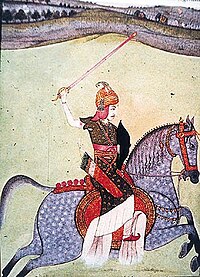Bajirao I
|
Shreemant Peshwa Bajirao बल्लाळ |
|
|---|---|
| श्रीमंत बाजीराव बाळाजी भट | |
 |
|
|
|
|
|
In office 27 April 1720 – 28 April 1740 |
|
| Monarch | Chhatrapati Shahu |
| Preceded by | Balaji Vishwanath(Ballalpant) |
| Succeeded by | Balaji Bajirao |
| Personal details | |
| Born | 18 August 1700 |
| Died | 28 April 1740 (aged 39) Raverkhedi |
| Spouse(s) | Kashibai, Mastani |
| Relations | Chimaji Appa (brother) |
| Children | Nanasaheb (Balaji Bajirao), Raghunathrao and Shamsher Bahadur I (Krishna Rao) |
| Parents | Balaji Vishwanath and Radhabai |
| Religion | Hinduism |
Bajirao I (18 August 1700 – 28 April 1740) was a general of the Maratha Empire in India. He served as Peshwa (Prime Minister) to the fourth Maratha Chhatrapati (king) Shahu from 1720 until Bajirao's death. He is also known by the names Bajirao Ballal and Thorale (Marathi for Elder) Bajirao.
Bajirao is credited with expanding the Maratha Empire, especially in the north, which contributed to its reaching a zenith during his son's reign twenty years after his death. In his brief military career spanning 20 years, Bajirao never lost a battle. According to the British Army officer Bernard Montgomery, Bajirao was possibly the finest cavalry general ever produced by India.
Bajirao was born into the Bhat family of Kokanastha Chitpavan Brahmin lineage. His father Balaji Vishwanath was the first Peshwa of Chhatrapati Shahu; his mother was Radhabai. Bajirao had a younger brother Chimaji Appa.
Bajirao would often accompany his father on military campaigns. He was with his father when the latter was imprisoned by Damaji Thorat before being released for a ransom. When Vishwanath died in 1720, Shahu appointed the 20-year old Bajirao as the Peshwa. He is said to have preached the ideal of Hindu Pad Padshahi (Hindu Empire),
Bajirao I intended to plant the Maratha flag upon the walls of Delhi and other cities governed by the Mughals and their subjects. He intended to replace the Mughal Empire and create a Hindu-Pat-Padshahi.
By the time Bajirao became the Peshwa, Chhatrapati Shahu was almost a titular ruler, largely confined to his residence in Satara. The Maratha confederacy was run in his name, but the real power lay in the hands of the Peshwa. By the time of Bajirao's appointment, the Mughal emperor Muhammad Shah had recognized Marathas' rights over the territories possessed by Shivaji at his death. In 1719, the Mughals had also recognized the Maratha rights to collect taxes (chauth or chauthaii and sardeshmukhi) in the six provinces of Deccan. Bajirao believed that the Mughal Empire was in decline, and wanted to take advantage of this situation with aggressive expansion in north India. Sensing the declining fortune of the Mughals, he is reported to have said, "Strike, strike at the trunk and the branches will fall off themselves." However, as a new Peshwa, he faced several challenges:,
...
Wikipedia
